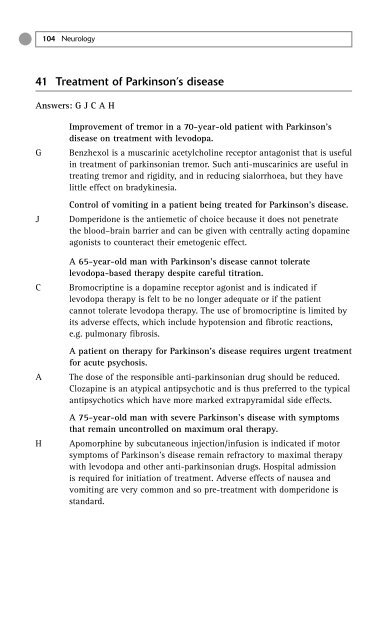EMQs in Clinical Medicine.pdf - Peshawar Medical College
EMQs in Clinical Medicine.pdf - Peshawar Medical College
EMQs in Clinical Medicine.pdf - Peshawar Medical College
Create successful ePaper yourself
Turn your PDF publications into a flip-book with our unique Google optimized e-Paper software.
104 Neurology<br />
41 Treatment of Park<strong>in</strong>son’s disease<br />
Answers: G J C A H<br />
G<br />
J<br />
C<br />
A<br />
H<br />
Improvement of tremor <strong>in</strong> a 70-year-old patient with Park<strong>in</strong>son’s<br />
disease on treatment with levodopa.<br />
Benzhexol is a muscar<strong>in</strong>ic acetylchol<strong>in</strong>e receptor antagonist that is useful<br />
<strong>in</strong> treatment of park<strong>in</strong>sonian tremor. Such anti-muscar<strong>in</strong>ics are useful <strong>in</strong><br />
treat<strong>in</strong>g tremor and rigidity, and <strong>in</strong> reduc<strong>in</strong>g sialorrhoea, but they have<br />
little effect on bradyk<strong>in</strong>esia.<br />
Control of vomit<strong>in</strong>g <strong>in</strong> a patient be<strong>in</strong>g treated for Park<strong>in</strong>son’s disease.<br />
Domperidone is the antiemetic of choice because it does not penetrate<br />
the blood–bra<strong>in</strong> barrier and can be given with centrally act<strong>in</strong>g dopam<strong>in</strong>e<br />
agonists to counteract their emetogenic effect.<br />
A 65-year-old man with Park<strong>in</strong>son’s disease cannot tolerate<br />
levodopa-based therapy despite careful titration.<br />
Bromocript<strong>in</strong>e is a dopam<strong>in</strong>e receptor agonist and is <strong>in</strong>dicated if<br />
levodopa therapy is felt to be no longer adequate or if the patient<br />
cannot tolerate levodopa therapy. The use of bromocript<strong>in</strong>e is limited by<br />
its adverse effects, which <strong>in</strong>clude hypotension and fibrotic reactions,<br />
e.g. pulmonary fibrosis.<br />
A patient on therapy for Park<strong>in</strong>son’s disease requires urgent treatment<br />
for acute psychosis.<br />
The dose of the responsible anti-park<strong>in</strong>sonian drug should be reduced.<br />
Clozap<strong>in</strong>e is an atypical antipsychotic and is thus preferred to the typical<br />
antipsychotics which have more marked extrapyramidal side effects.<br />
A 75-year-old man with severe Park<strong>in</strong>son’s disease with symptoms<br />
that rema<strong>in</strong> uncontrolled on maximum oral therapy.<br />
Apomorph<strong>in</strong>e by subcutaneous <strong>in</strong>jection/<strong>in</strong>fusion is <strong>in</strong>dicated if motor<br />
symptoms of Park<strong>in</strong>son’s disease rema<strong>in</strong> refractory to maximal therapy<br />
with levodopa and other anti-park<strong>in</strong>sonian drugs. Hospital admission<br />
is required for <strong>in</strong>itiation of treatment. Adverse effects of nausea and<br />
vomit<strong>in</strong>g are very common and so pre-treatment with domperidone is<br />
standard.












